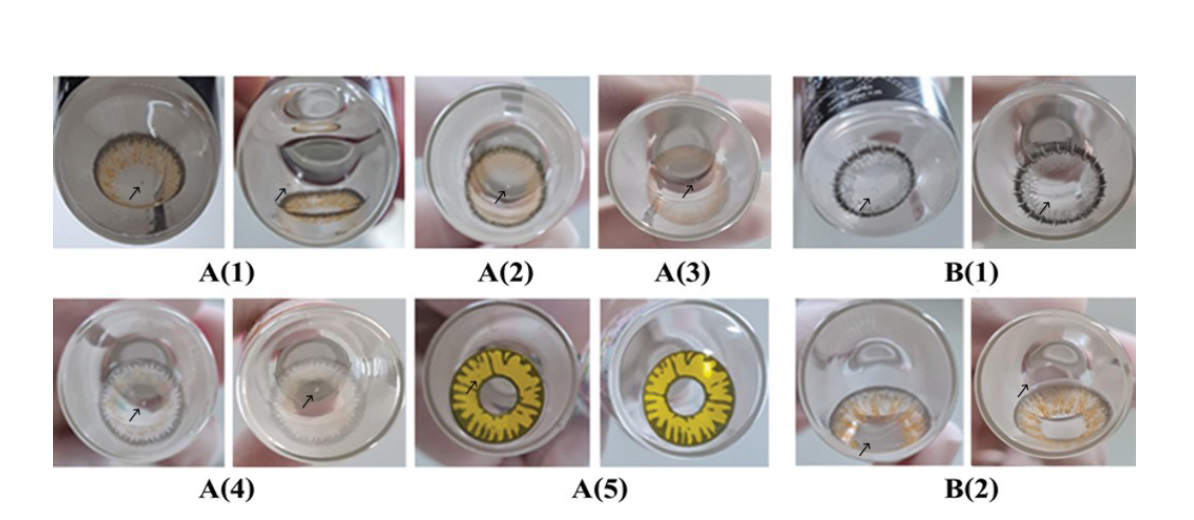Visual Inspection of Non-Prescription Monthly Colored Contact Lenses: Safety Issues for Contact Lens Wearers
DOI:
https://doi.org/10.33192/Smj.2021.76Keywords:
colored contact lens, e-marketplace, defective product, dirty product, foreign bodyAbstract
Objective: To survey the prevalence of non-prescription monthly colored contact lenses (CL) defects in an electronic
marketplace (e-marketplace) in Thailand using visual inspection (VI).
Materials and Methods: This cross-sectional study included the 252 items listed from 23 online shops in an
e-marketplace in Thailand during April 2021. Online customer reviews for each shop were examined and complaints
regarding colored CL product defects, delivery, services and abnormal symptoms after use were collected. Product
packing and visible internal and external product characteristics were visually inspected under sufficient light for
the prevalence of defects by three examiners.
Results: Sixteen out of twenty-three online shops (69.57%) had customer complaints. Wrong delivery was the most
common complaint (60.87%). Five characteristics of product defects were described by customers, of which abnormal
scratches/marks on CL (8.70%) was the most common. Abnormal symptoms after use were found in 43.84% of the
shops. Two hundred and thirty-seven pairs of colored CL (94.05%), 470 vials and four blisters from 19 shops were
examined. Defective products were found to be 8.02%. The most common visible external and internal product
defects were dirty products (3.80%) and foreign bodies in the original sealed manufacturer’s containers (1.90%),
respectively. Other defects, e.g. scratched or peeling label, incompletely closed aluminum cap, surface wear of CL,
abnormal scratches or marks on CL and immobility of CL in solution were also found.
Conclusion: Non-prescription monthly colored CL in the e-marketplace have many visible defective characteristics
that CL wearers should be concerned about. This study suggests that VI of CL products before use may be an
important potential safety factor for CL wearers.
References
Healthy contact lens wear and care: decorative contact lenses. Centers for disease control and prevention, U.S. Department of Health & Human Services. [cited 22 April 2021]. Available from: http://www.cdc.gov/contact lenses/decorative-contacts. html
Udomsuk L, Siramon S. Safety situation of monthly colored cosmetic contact lenses from markets in one district of Ubon Ratchathani, Thailand. CHJ 2021;46(1):21-8.
Kanchanaranya N. Rojdamrongratana D. Tuachob Y. Suwantarat N. Setabutr P. Mungkornkaew N. How safe are coloured contact lenses illegally sold on street in Thailand? EYESEA 2018;13:38-42.
Rojanabenjawong C, Kahornlaph T, Detphiphatsuphanon S, Jumroon N. Detection of bacterial contamination on contact lenses from the flea market. Buddhachinaraj Med J 2017;34:307-12.
Paensuwan P, Leedasawat P, Chaiyasan W, Pejchang D. Impact of self-contact lens fitting with uncorrected refractive error on visual acuity and lens movement in contact lens wearer. Chula Med J 2019;63(2):79-87.
Johnson TL, Fletcher SR, Baker W, Charles RL. How and why we need to capture tacit knowledge in manufacturing: case studies of visual inspection. Appl Ergon 2019;74:1-9.
Li GG, Cao S, Jiao N, Wen ZQ. Classification of glass particles in parenteral product vials by visual, microscopic, and spectroscopic methods. PDA J Pharm Sci Technol 2014;68(4):362-72.
Lin HD, Chiu YSP, Hsu SY. A visual inspection system for quality control of optical lenses. Int. J Phys Sci 2011;6(11):2701-9.
Bukofzer S, Ayres J, Chavez A, Devera M, Miller J. Industry perspective on the medical risk of visible particles in injectable durg products. PDA J Pharm Sci Technol 2015;69(1):123-39.
Tananuvat N, Punyakhum O, Ausayakhun S, Chaidaroon W. Etiology and clinical outcomes of microbial keratitis at a tertiary eye-care center in northern Thailand. J Med Assoc Thai 2012;95: 8-17.
Preechawat P, Ratananikom U, Lerdvitayasakul R, Kunavisarut S. Contact lens-related microbial keratitis. J Med Assoc Thai 2007;90:737-43.
Khor WB, Prajna V, Garg P, Mehta JS, Wie L, Liu Z, et al. The Asia cornea society infectious keratitis study: a prospective multicenter study of infectious keratitis in Asia. Am J Ophthalmol 2018;195:161-70.
Tasanee S, Tisha P, Achavee S, Roy CS, Anun V. Predisposing factors and etiologic diagnosis of ulcerative keratitis. Cornea 2008;27:283-7.
Lelievre L, Borderie V, Hermoso DG, Brignier AC, Sterkerrs M, Chaumeil C, et al. Imported Pythium insidiosum keratitis after a swim in Thailand by a contact lens-wearing traveler. Am J Trop Med Hyg 2015;92(2):270-3.
Lim CHL, Stapleton F, Mehta JS. Review of contact lens-related complications. Eye Contact Lens 2018;Suppl 2:S1-10.
Alipour F, Khaheshi S, Soleimanzadeh M, Heidarzadeh S, Heydarzadeh S. Contact lens-related complications: A Review. J Ophthalmic Vis Res 2017;12(2):193-204.
Land AD, Penno KL, Brzezinski JL. Identification of microorganisms isolated from counterfeit and unapproved decorative contact lenses. J Forensic Sci 2018;63(2):635-9.
O’Neill DP, Matheson MM. Warning about bacterial contamination of therapeutic contact lenses. Eye 1991;5(5):612-4.
Durban JJ, Villaverde EH, Monteoliva-sanchez M, Ramonscormenzana A. Bacterial contamination of hydrophillic contact lenses solutions marketed in Spain. Optom Vis Sci 1996;73(8): 529-32.
Pandey AN. Ocular foreign bodies: a review. J Clin Exp Ophthalmol 2017; 645.

Downloads
Published
How to Cite
Issue
Section
License
Authors who publish with this journal agree to the following conditions:
Copyright Transfer
In submitting a manuscript, the authors acknowledge that the work will become the copyrighted property of Siriraj Medical Journal upon publication.
License
Articles are licensed under a Creative Commons Attribution-NonCommercial-NoDerivatives 4.0 International License (CC BY-NC-ND 4.0). This license allows for the sharing of the work for non-commercial purposes with proper attribution to the authors and the journal. However, it does not permit modifications or the creation of derivative works.
Sharing and Access
Authors are encouraged to share their article on their personal or institutional websites and through other non-commercial platforms. Doing so can increase readership and citations.














